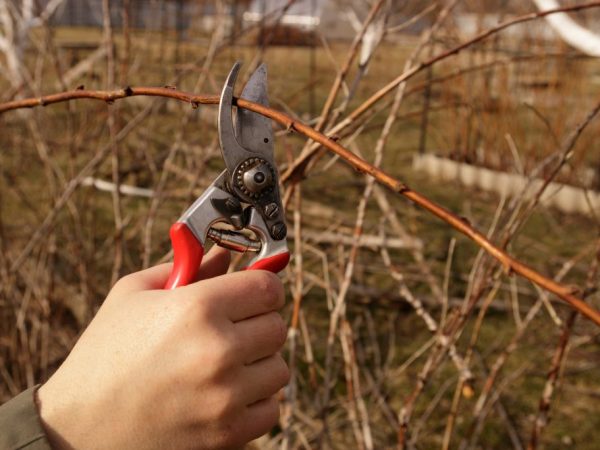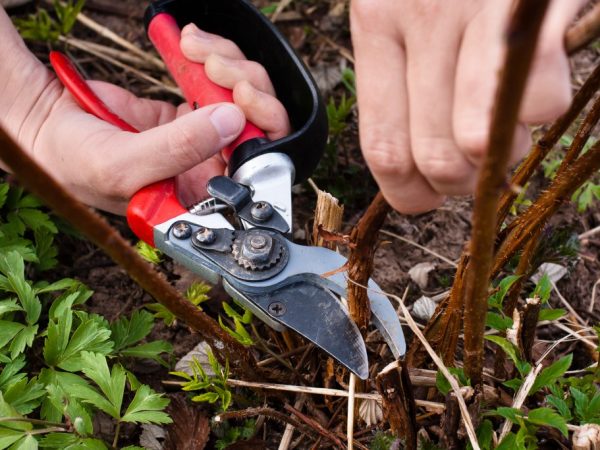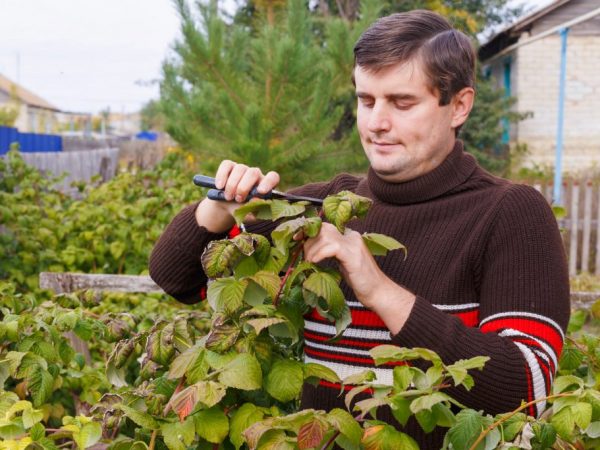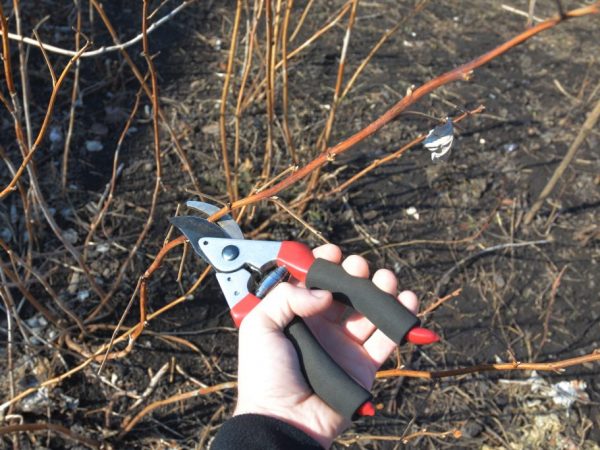Rules for pruning raspberries in the fall - simple schemes
Correct pruning of raspberries in the fall is a guarantee of the harvest for the next season. It is carried out on time and according to certain schemes. There are several technologies that gardeners use successfully. Subsequent proper care will be the final stage so that thickets do not turn out from the fruit and berry crop.

Rules for pruning raspberries in the fall - simple schemes
Purpose of the procedure
In order for the raspberry bush to bear fruit and bring a good harvest after planting, it must be pruned several times throughout the season.
Initially, the bush is shortened in the spring after the snow melts, then trimmed in the summer after picking the berries, and the final pruning occurs in the fall when preparing the plant for winter.
In each period of appointment, the procedures are different:
- in spring it must be carried out after planting or transplanting to a new place in order to extend the fruiting stage, because the shorter the shoot, the later it will begin to bear berries;
- in summer, its task is to redistribute food flows to young branches with fruit buds;
- in the fall, it is made for sanitary purposes, followed by bending and garter.
Pruning is also necessary for a number of other reasons:
- old branches more than 2 years old become useless in terms of fruiting, therefore raspberries are cut all to the ground in order to avoid thickening in summer;
- trimmed shrubs free up space and do not create a favorable environment for the development of fungal and viral infections;
- remote and shortened shoots give rise to new fruiting shoots.
If you leave the branches in full length at the raspberry bush and do not interfere with the fruit and berry culture to actively increase the green mass, this will soon lead to a significant decrease in yield and cause the berries to shrink. Broken and dry shoots preserved on the plant will interfere with the appearance of fresh and young ones.
Pruning time
Autumn pruning of raspberries is necessary mainly in order to remove old two-year-old stems that previously brought berries. In the third year of life, the harvest will become smaller, the berries will become much smaller.
The main rule is not to rush, because this can provoke the growth of fresh shoots and awakening of the buds, and not be late, finishing it before the first autumn frosts.
Early pruning is suitable for those shrubs in which young shoots are lagging behind in development.
Usually gardeners start the procedure in September - October. These dates may shift depending on the region of cultivation, and some summer residents prefer to plan events according to the recommendations of the lunar calendar.
The latest pruning time belongs to the late fruiting remontant varieties, especially the frost-resistant yellow, which bring crops up to snowfall, and the very first they try to shorten common raspberries - immediately after picking berries, sometimes already in late July - early August.
Influence of regional characteristics
The timing for cutting the bush varies by region:
- in the south, where autumn is warm, it is spent much later, in October, but it should not be delayed, because when heat is retained in combination with humid weather, pests are activated, accumulating food for winter hibernation;
- in the central region, incl. Moscow region, they are trying to remove unnecessary shoots already in August, ending by the first half of September;
- in the northern regions, for example, in the Urals and Siberia, the optimal time is the end of August.
Long-term weather forecasts should be used when planning your pruning to avoid a sudden cold snap.
The basic rule is to complete all activities 2-3 weeks before a strong drop in air temperature.
Moon calendar

The procedure is not recommended to be carried out on a full moon.
The best time for the event is the waning phases of the moon, when the plant sap begins to move in the direction from the growth points to the root system.
It is not advised to carry out work on the full moon and new moon. A poorly sharpened tool will crumble branches. As a result of damage, they will not be resistant to winter cold.
Necessary tools
Before carrying out the autumn trimming procedure, a toolkit is prepared in advance:
- pruning shears - must be well sharpened, it is possible to replace it with garden shears;
- garden knife - for cutting uneven stems;
- lopper - used on thick branches.
All instruments should be treated with disinfectants.
Technologies and rules
The classic scheme for pruning raspberries is to follow some simple rules:
- remove weak tops to the place of growth of a healthy kidney;
- the height to which the plant is shortened is not more than 1.5 m;
- the permissible size of shortening of each branch is up to 25 cm.
There are several technologies - they are used to form different types of raspberry bushes, taking into account their characteristics.
Traditional way
Ordinary varieties with a fast growth rate are shortened by a greater length in comparison with those that have a normal intensity of development. This helps to prolong the period of fruiting.
In this case, the pruning is distributed so that the plant forms a tier. For this purpose, the branches are cut at different heights in stages, gradually reducing the gap to the ground surface.
Technology:
- initially shortening broken and weak branches that will not be able to withstand the winter cold;
- at the next stage, two-year-old shoots are removed, on which there will be no harvest or small berries will grow;
- at the end, annual shoots are cut, finally thinning the shrub.
Double undercut

Double pruning will wake up dormant buds
It is more often used for the standard Tarusa variety and provides a significant increase in yield for the next season.
Scheme:
- initially, young shoots are shortened, pinching the upper part by 10-15 cm;
- the next season, the top is cut off at the lateral processes to the same length.
As a result of the double procedure, dormant buds are activated on the lateral branches, from which new berries will form.
The technology shows the greatest efficiency if the distance between the rows is from 2 m, and between the bushes - from 1 m.
Sobolev method
The method of the Kurgan gardener Sobolev is based on improving the technology of conventional double pruning:
- at the end of spring, around May, the upper part of young branches is pruned to a shrub height of 1 m, this size ensures proper intake of food by the roots and its delivery to the stems, prevents damage to the shoots by the wind;
- in the summer they observe growth and form as needed;
- for the next season, the tops of fresh annual shoots and lateral biennial branches are necessarily cut off;
- after reaching the age of 2 years, the stems are removed, and in the spring, the two-year lateral branches and the upper part of the annual shoots are again shortened.
I repeat this scheme every year.Its principle of action is to activate single shoots for branching.
As a result, branching two-year-old shoots will have a good harvest, annual branches will actively bloom and young shoots will appear.
For remontant raspberries
Such varieties bear fruit for several months per season, and more than once, which requires a lot of nutrition.
Getting rid of unnecessary overgrowth helps to provide shoots with useful substances. This procedure is carried out after picking berries, at the last wave of fruiting.
Trimming events for yellow remontant raspberries are planned in the southern regions more often in late autumn, and in the northern regions they prefer to hold them in the spring.
Technology:
- two-year-old shoots at the end of fruiting are cut to the roots;
- annuals are pruned by 20 cm;
- the remaining vegetative parts are treated with Bordeaux liquid against infectious diseases.
In the spring, at the remontant fruit and berry culture, sanitary pruning is carried out, removing branches frozen over the winter, broken and dried up. Do it before bud break, approximately in March-April.
For one harvest

Full pruning will produce a good harvest.
According to this scheme, they are pruned to obtain one, but more abundant than usual, harvest of berries.
The procedure consists in cutting off all the stems to the surface of the earth immediately after the arrival of the first autumn frosts.
If it is carried out before the onset of cold weather in the fall, this can provoke the appearance of fresh shoots that will not grow stronger before winter and will die.
With the arrival of spring, the raspberry bush is thinned out, leaving up to four of the strongest branches on it.
For two harvests
If you intend to collect two good harvests of berries from a tree in one season, they are cut from remontant varieties in 2 stages:
- initially, at the end of the first fruiting, the bush is trimmed to the base, two-year-old shoots that have borne fruit at the root;
- after the second wave, which occurs more often in September-October and passes in the upper part of the bush, this part is shortened.
For raspberry Cumberland
The black raspberry variety is recommended to be trimmed when autumn arrives. They do this in order to increase yields. In the spring, sanitary pruning is carried out for her.
Scheme:
- pinch the shoots at the points of growth, from where the fruit branches grow the next season;
- the length by which the two-year tops are shortened is 30 cm, for annuals this value is 50 cm;
- no more than 8 strongest branches are left on the bush;
- in spring, for sanitary purposes, they remove damaged and frozen branches.
Follow-up care
After shortening, the raspberry bush needs proper care:
- the plant is watered at the rate of 50-60 liters for each;
- the soil around the raspberries is covered with a layer of mulch in order to retain moisture, dry grass, deciduous litter, humus, peat, sawdust are suitable as it;
- the bush is covered for the winter with the help of covering artificial or natural materials;
- fruit and berry crops are fed, for feeding they use manure, poultry droppings, mineral complexes, organic matter, humus.
Common mistakes
Gardeners often make a number of common mistakes when caring for a raspberry bush:
- leave young growth, which lowers productivity and provokes the appearance of infectious diseases;
- completely ignore or violate the schedule of fertilizing, which help the plant to recover after the trimming procedure and maintain strength for the winter;
- forget about treatments for pests and infections that weaken the immune system of the bush;
- watering raspberries after pruning is not enough, or watering is carried out at a shallow depth, not completely moistening the roots.
Summing up
To get good yields from a raspberry bush, it is worth taking proper care of it. One of the components of caring for a fruit and berry crop is pruning. There are several technologies that are used for different varieties.The shrub is pruned at a certain time, depending on the regional characteristics of cultivation.
For beginners, it is recommended to follow the instructions in the pictures. Some gardeners are additionally guided by the lunar calendar.

